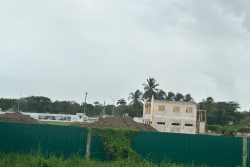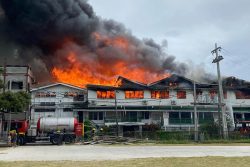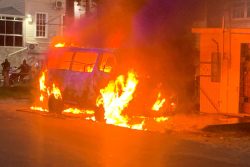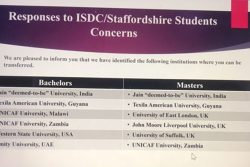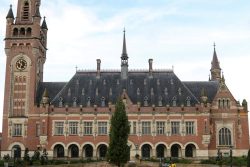The container in which cocaine-filled logs were found on Tuesday was flagged for irregularities since it was scanned on January 30th by the Guyana Revenue Authority (GRA) but it remained at a city wharf for almost three weeks before a decision was made to have it searched, a source has said.
Anti-narcotics agents yesterday continued their investigations into the discovery, while the three men held in connection with the find—which has now been officially pegged at 359.8 kilos (792 pounds)—remained in custody. A Dutchman and two Guyanese nationals were detained over the bust.
According to James Singh, head of the Customs and Anti-Narcotic Unit (CANU), advice is being sought from the Director of Public Prosecutions (DPP) as to the way forward.
Singh explained that it was 314 bricks and not kilos that were recovered from the logs, which was verified through weighing. Based on the original destination for the shipment, he said each kilo would have had a street value of US$25,000.
The delay between the detection of irregularities in the container, registered to the Dutch-owned Guyana Timber Products Inc., and the decision to conduct a search has raised questions.
A source close to the investigation told Stabroek News yesterday that although anomalies were detected during the scanning process, CANU was never notified. CANU ranks, according to the source, were only notified that there were things wrong with the container on Tuesday morning and they accompanied it from a city wharf to Guyana Timber Products Inc, which is located at Lot 80 Soesdyke Public Road.
The source pointed out that the relevant officials were put on alert to pay special attention to anything being shipped under that company’s name, since it was on the radar of CANU following a similar incident some time back.
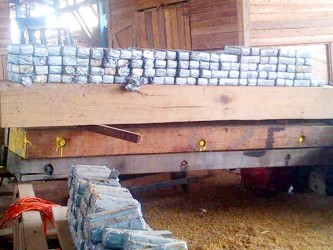
Commissioner General of the GRA Khurshid Sattaur told Stabroek News yesterday that the container remained at the wharf for a period of time, but when asked how long it had been there, said “since the end of last month” and did not provide more details.
However, a statement from the GRA subsequently confirmed that anomalies were discovered on January 30, during the scanning of seven containers of Mats of Hardwood (MHW) that the company sought to ship to the Netherlands.
According to the statement, on January 17 Customs Declaration number C2474 was presented to the GRA’s Drug Enforcement Unit (DEU) by a representative of the Guyana Timber Products Inc. to be processed for the exportation of seven containers of MHW. Four days later, the shipment was inspected and certified by the Guyana Forestry Commission (GFC) and issued with the relevant certifications by the said agency.
The statement said that subsequently, the Commercial Invoice, C72 Form, Timber Marketing Certificate, Export Certificate and the General System of Preferencing Certificate of Origin were submitted to the GRA for the shipment of seven containers.
“However, on January 30, 2013, whilst the containers were being scanned anomalies were observed and three containers, with the numbers TEMU 3177872-7, CMAU 120027-1 and ECMU 156081-4 sealed with the CTA seal numbers 161100 ,161102 and 174880 respectively, were determined necessary for a secondary examination out of a total of seven that were scheduled to be exported,” the statement said.
“It was determined that the images were not in keeping with the information contained on the C72 Form, which clearly indicated that the content of the containers were the MHW. Among the contents of container ECMU 156081 were blocks of hardwood,” the GRA noted, while adding that its Standard Operating Procedures require its staff to establish that the contents in the containers are in keeping with what is contained on the C72 Forms.
DEU officials noted that there were discrepancies in the physical content and colour coding of some of the logs and after it was confirmed that those were the logs that presented the anomalies, instructions were given for one of the logs to be drilled, the GRA said.
“This resulted in the discovery of a white powdery substance which was tested and revealed to be cocaine. The logs numbering eight (8) in numbers were pried open in the presence of officials from CANU, DEU, GFC and the Shipping agent. Each plank, with the exception of one, contained a total of forty bricks. At the completion of the examination a total of three hundred and fourteen (314) bricks of cocaine were discovered,” it added.
The GRA said that its officers operated in a professional manner and followed all established Standard Operating Procedures. “…as such [they] must be commended for their professionalism and diligence in the execution of their duties,” the statement said, adding that the entity is continuing its investigation of any possible involvement by external agencies and the exporter in attempting to secrete the substance in the logs that were destined for Holland.
Source
The bust comes on the heels of several other large discoveries within the last few months, which continue to raise questions about the source of the drugs. Security experts for years have said that there is no doubt that the cocaine is entering Guyana through the miles of unmanned borders, with the Guyana/Venezuela border area identified as the most likely used point of entry.
When asked about the source of the cocaine, Singh told Stabroek News yesterday that if he knew where it was coming from, he “would be right there stopping it.”
Last December, Opposition Leader David Granger said that while “big noise” was being made over the interception of cocaine shipments, nothing was being said about how the drugs are getting into the country in the first place.
Granger, a former national security adviser, said that based on the amounts of cocaine that had been intercepted, he believed that it was entering Guyana by air. He had said that with 1,100 kilometres of unmanned border between Guyana and Brazil, an aircraft would be needed to effectively patrol this area. Other sources have said that because of the country’s poor border security and the forested interior, it would be easy for a small aircraft to land here undetected.
Meanwhile, AFC leader Khemraj Ramjattan yesterday congratulated CANU, GRA and the GFC in making the huge bust but called on them to go the “full gamut” in their investigations and when “they see big players in society are involved, try to catch them and bring them to justice.”
This, he said, could only improve the country’s image as the country continues to pay a huge price on the drug trafficking front since there are more “negatives than positives.” But he dubbed Tuesday’s bust as a good start in reversing the situation, especially when the ABC countries—especially America—have called on Guyana to do more to battle drug trafficking.
He added that the AFC knows from a “variety of sources” that drug trafficking is huge in the lumber industry and other exporting industries.
He said that in view of the Security Sector Reform that is being touted by the government, it would now encourage more of Tuesday’s exercises and “intelligence gathering to gather these major players.”
“We believe that the time is coming when this government must realise that cocaine out of Guyana is doing a huge harm, we see it already with Delta pulling out… We can’t continue to pay that huge price,” Ramjattan noted.
Largest bust
While Tuesday’s bust is the largest in recent years, it is not the largest in Guyana’s history, as was claimed by the GRA in its statement.
In October 1998, CANU ranks with support from US drug officials found 6,940 pounds of cocaine, valued at US$288 million on board the MV Danielsen.
The St Vincent-registered vessel had travelled from Panama to Guyana and arrived here on October 10, 1998. The cocaine was found on October 22.
Local security forces had searched but found nothing and later sought the assistance of the US Coastguard and the US Drug Enforcement Agency (DEA), which had sophisticated equipment that found the drugs in the cargo hold.
Captain of the boat, Panamanian Thomas Fortune, was arrested shortly after the find. During his court appearance, he pleaded guilty and was sentenced to five years in prison together with a fine of $7.6 billion. The seven crew members were deported to their respective country of origin, while the boat was confiscated by the state and the drugs later dumped in the Atlantic.
Lumber has previously been used as a cover by traffickers to smuggle cocaine out of Guyana.
In November 2005, six Guyanese were charged and later convicted in Barbados after 91.3 kilogrammes of cannabis and 119.4 kilogrammes of cocaine were found in a ship of lumber. The shipment arrived on the island from Guyana.
On March 16, 2011, Jamaican customs authorities discovered five bags containing 122.65 kilogrammes of cocaine, with a street value of $700 million, among timber in a container on the MV Vega Azurit. Reports had indicated that the vessel, which left Guyana just days before, is one that frequents Guyana almost twice weekly. Months later, two GRA officers were dismissed and another suspended in connection with the case. A decision to terminate the officers’ services was made after a thorough investigation was conducted by the entity’s Internal Affairs Division. The investigation revealed that there were breaches of several customs laws, policies, standard operating procedures and employees’ conduct codes.
The most recent busts occurred here last November, where 300 kilogrammes of cocaine were found concealed in packaged soap powder; in December, when 21.8 kilogrammes of cocaine were found in drinking strains which were made to look like macaroni, and 233 kilos were found concealed in fish food; and earlier this month, when 36.3 kilogrammes of cocaine were found in a house in Ogle.
